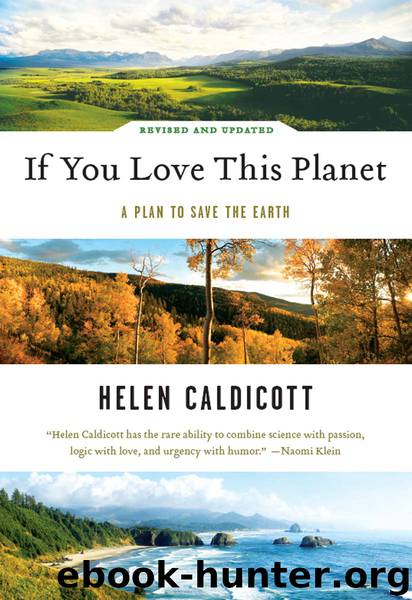If You Love This Planet: A Plan to Save the Earth (Revised and Updated) by Helen Caldicott

Author:Helen Caldicott [Caldicott, Helen]
Language: eng
Format: epub
ISBN: 9780393333022
Amazon: 0393308359
Publisher: W. W. Norton & Company
Published: 1992-01-01T23:00:00+00:00
Although China is now the number one consumer of fertilizer, using more than 40 million tons in 2004, the average American uses an estimated 530,000 gallons (about 2 million liters) of water per year, 80 percent of which is allocated to food production.17 On a daily basis, the United States consumes the equivalent of 2,200 pounds (about 1,000 kilograms) of food per person.18
The Feinstein World Hunger Program at Brown University estimates that if the world population is fed primarily with grains and vegetables, there is, at present, enough food to ensure the USDA recommended daily per capita intake of 2,200 calories for the global population.19 But while billions starve, about two-thirds of the grain grown in the world and half the fish caught are fed to animals in rich countries. If the world’s population reaches eleven billion, its annual food production must increase two and a half times merely to maintain the current situation and low per capita output.20 We have work to do!
About 60 percent of the world’s best agricultural land is situated in only twenty-nine countries, and over 40 percent of the world’s agricultural land has been badly degraded.21 A mere 11 percent of the land area of the planet is suitable for agriculture, yet soil erosion associated with deforestation, dam construction, and irrigation is depleting 75 billion tons of the world’s topsoil each year.22 Our global treasure is being lost in the sea and silting up rivers. In addition, about 2.5 million acres (1 million hectares) of rich farmland in the United States—an area more than double the size of Delaware—is destroyed by “development,” covered with asphalt, freeways, houses, and shopping centers.
In a world where equitable redistribution of wealth is vital, let’s now discuss the financial support that the wealthy 20 percent currently give to the poor 80 percent. In 2007, the United States spent over $625 billion on its military, while, in contrast, it contributed only $22.7 billion in foreign aid in 2006. Unfortunately, only $2 billion went for food, $3.2 billion for humanitarian aid, and $5.6 billion for sub-Saharan Africa.23 Of the $22.7 billion in US government foreign aid in 2006, Israel received the largest amount—$2.5 billion, most of which it spent on its military—Egypt received the second-largest amount, followed by Iraq and Afghanistan; and only four of the world’s poorest nations—Ethiopia, Liberia, Uganda, and Tanzania—were among the top twenty listed aid recipients.24 US citizens, however, tend to be more generous than their government, giving $34 billion in private overseas donations in 2006.25 Note the radical difference between spending money on killing versus spending money to help needy people throughout the world. The most needy countries were and are continually shortchanged.26
Most aid serves as an instrument of foreign policy, not really as a charitable gift. For example, during the years 1991–2003, the United States organized through the UN to impose sanctions on Iraq, depriving it of necessary food imports and medical drugs, which helped to lead to the deaths of five thousand children from malnutrition and waterborne diseases each month.
Download
This site does not store any files on its server. We only index and link to content provided by other sites. Please contact the content providers to delete copyright contents if any and email us, we'll remove relevant links or contents immediately.
The Lonely City by Olivia Laing(4768)
Animal Frequency by Melissa Alvarez(4424)
All Creatures Great and Small by James Herriot(4268)
Walking by Henry David Thoreau(3922)
Exit West by Mohsin Hamid(3794)
Origin Story: A Big History of Everything by David Christian(3666)
COSMOS by Carl Sagan(3588)
How to Read Water: Clues and Patterns from Puddles to the Sea (Natural Navigation) by Tristan Gooley(3430)
Hedgerow by John Wright(3316)
How to Read Nature by Tristan Gooley(3290)
The Inner Life of Animals by Peter Wohlleben(3285)
How to Do Nothing by Jenny Odell(3263)
Project Animal Farm: An Accidental Journey into the Secret World of Farming and the Truth About Our Food by Sonia Faruqi(3189)
Origin Story by David Christian(3170)
Water by Ian Miller(3155)
A Forest Journey by John Perlin(3042)
The Plant Messiah by Carlos Magdalena(2900)
A Wilder Time by William E. Glassley(2833)
Forests: A Very Short Introduction by Jaboury Ghazoul(2815)
